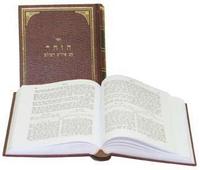Rabbi Hya's Vision
Rabbi Hya's vision is The Zohar’s subtle way of telling us about mutual responsibility.
“Rabbi Hya fell to the ground, kissed the dust and wept, and said…”
The Book of Zohar, Introduction, item 49.
There is a story about Rabbi Hya, one of Rabbi Shimon Bar-Yochai’s prime students, the same students with whom he wrote The Book of Zohar. The story begins with a question that Rabbi Hya asked about his teacher’s soul.
From the height of his spiritual attainment, Rabbi Hya saw that souls return to their root, their highest spiritual state, only after they correct the egoistic desires within them. For this reason, Rabbi Hya asked how a soul as high as Rabbi Shimon’s could not complete its correction, but had to wait until all the other souls completed their correction, too.
Rabbi Hya couldn’t comprehend how such a great Kabbalist, through whom Light emits to the whole world, could not correct himself before the last person completed his or her spiritual vocation. The Zohar says that this question put Rabbi Hya in such turmoil that he fell to the ground, wept, and said: “Dust, o dust, how obstinate you are, how insolent? You consume all the pillars of light in the world; how impudent are you? The holy Light that emitted to the world, Rabbi Shimon Bar-Yochai, whose merit sustains the world, was swallowed in you.”
According to the wisdom of Kabbalah, a person reincarnates in this world to correct his or her soul. The correction process begins with the Creator’s desire to grant all the abundance and goodness He possesses. For this reason, He created a creature called, “the common (collective) soul.”
Subsequently, the creature was shattered into many fragments called “souls.” These souls lost their contact with the Creator. They drew farther away from Him, ultimately arriving at the lowest state of existence, called “this world.” From that state, people should begin to correct their souls and reunite with the Creator.
The wisdom of Kabbalah explains that the correction process must happen while the individual is still alive in this world, clothed in a flesh and blood body. The purpose of the process is to allow souls to independently achieve contact with their Creator, but this time they must do it consciously and of their own volition.
Prior to their descent into this world, souls were connected in the spiritual world through ties of love and giving. The decline into this world symbolizes the detachment of souls from one another to the current point of their inability to sense their interconnectedness. It is our task to reconstruct those connections while living in this world and gradually return to our initial, complete state. At the end of the process, called Gmar Tikkun ha Pratti (Individual End of Correction), each soul corrects itself and returns to the spiritual world. The state in which all the souls correct themselves is called Gmar Tikkun ha Klali (Collective End of Correction).
The “dust” on which Rabbi Hya fell in the story symbolizes the uncorrected souls that, in their state of corruption, hinder higher souls from achieving Gmar Tikkun. Rabbi Hya could not accept the fact that this process detained the soul of Rabbi Shimon, who was seemingly forced to wait for the Collective Gmar Tikkun to correct his soul. This is why Rabbi Hya demanded to “see” Rabbi Shimon, meaning to rise to a state where he could understand the order of the correction of the souls and thus receive an answer to his question.
Yet, Rabbi Hya’s request was turned down because he was still not worthy of climbing to that sublime state. In response, Rabbi Hya decided to “fast for forty days.” In Kabbalah, this act represents the acquisition of the quality of Bina, represented by the Hebrew letter Mem (whose numeric value is 40). After Rabbi Hya’s request was turned down for the second time, he continued to fast for yet another forty days, correcting himself even more and rising to a higher spiritual degree. Only then was he elevated to the “Supernal Seminary,” a state where all the corrected souls are bonded in love, attached to the Creator and filled with the Upper Light.
When Rabbi Hya climbed to that spiritual degree, he seemingly observed himself from the outside and discovered that his soul was already there, among the corrected souls, in the state of Gmar Tikkun. This amazed him even more: how could his corrected state exist before he, Rabbi Hya, had completed the correction of his soul?
The Book of Zohar uses the story of Rabbi Hya as a vehicle to explain that the whole of reality already exists. We are already included in the state of Gmar Tikkun, in our fullest glory and splendor. This world, however, is only a false picture that we experience in our present state of development.
The Zohar reveals a new perspective on life: that all the troubles and suffering we experience are intended to make us realize our own imperfections. To rise to the perception of the complete reality, we need to prefer the internal to the external, to find opportunities to incorporate the wisdom of Kabbalah into our lives. When we do that, we will rise, like Rabbi Hya, to a higher spiritual state, to the reality we truly do exist in. In that state we will be like all the Kabbalists before us, and discover the reality where all the souls are united in their perfect state.
